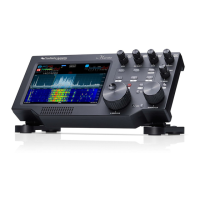FLEX-6000 Signature Series – Maestro User Guide
Page 65
Copyright 2019 FlexRadio Systems. All Rights Reserved.
Note: Maestro has an override feature which allows microphones other than the selected
microphone to be used during a transmission. This is discussed in section 15.4, PTT Override
when Operating below.
15.3 CONFIGURING THE AUDIO OUTPUT DEVICES
The Maestro provides several audio output options. A speaker is built into the front panel of the
Maestro. The Front Speaker button in the Audio control panel of the Main Menu enables and
disables the speaker. Plugging a headphone or similar device into the back-panel Phones connector
disables the front panel speaker regardless of the Front Speaker button state.
The back panel of the Maestro provides a connector for the connection of powered speakers and a
similar connector that provides a line level output. Plugging devices into these connectors does not
affect the front panel speaker.
15.4 PTT OVERRIDE WHEN OPERATING VIA MAESTRO
When operating in a non DIGx mode, using a hardware PTT such as the RCA PTT input on the
transceiver back panel or the transceiver front panel microphone PTT will override the Maestro PTT.
This feature is provided to allow an operator at the transceiver to override the Maestro input with a
PTT switch connected directly to the radio.
15.5 OPERATING CW WHEN OPERATING VIA MAESTRO
A key or paddles can be connected to the Maestro back panel Key connector. CW signals generated
by the internal Winkeyer 3 module are transmitted from Maestro to the transceiver across the
network connection. Sidetone from the keyer is generated inside Maestro and played out of the
speaker, headphones or powered speaker output. CW operation, especially in contest and DX
environments, tends to be fast paced and relatively intolerant of delays which can add confusion.
Many issues can affect the LAN performance of Maestro including, but not limited to, the wireless
router used, the congestion on local wireless channels, settings inside the router such as packet
coalescing and duplex modes, cabling issues such as interference from florescent light ballasts on the
wired connection to the router, etc. The network diagnostics in Maestro can help diagnose these,
but in the event that network issues are suspected, a thorough investigation of the network may be
in order.
Generally, wired networks will perform better than wireless networks. In many cases, the Internet
will have better packet latency and jitter performance than a wireless network with some degree of
congestion. For this reason, FlexRadio recommends using wired networks for CW as there tend to
be less issues that require troubleshooting on wired networks. Maestro will always attempt to
compensate for any jitter or latency caused by any kind of network, but the mechanism for
compensation is to add latency to ensure a steady stream of CW at the radio transmitter.
15.6 MONITORING REMOTE AUDIO AND NETWORK PERFORMANCE
There are two ways to monitor the performance of the network while using Maestro. The first is
with a convenient Network Health Indicator display in the top middle of the Maestro display. The
second is a detailed Network Diagnostics display.

